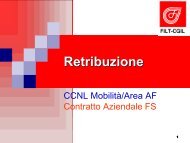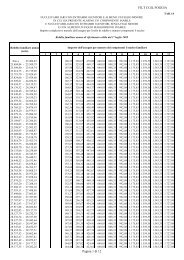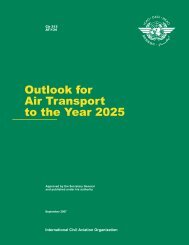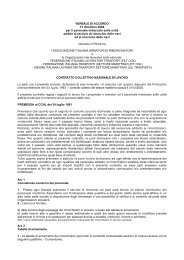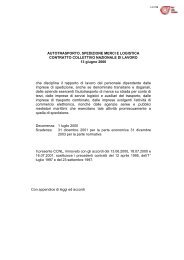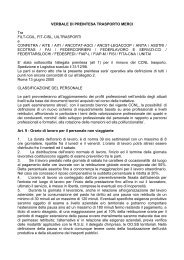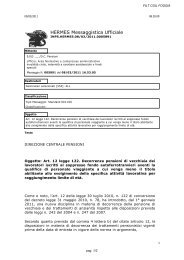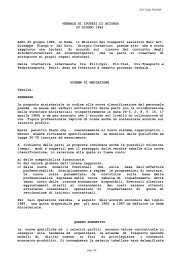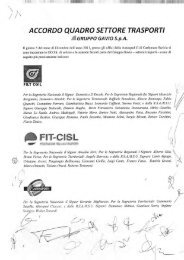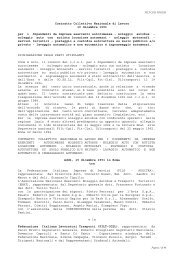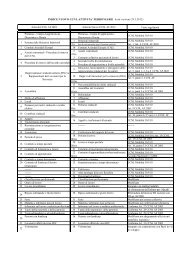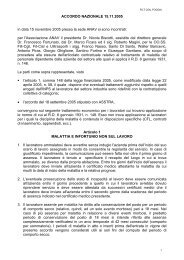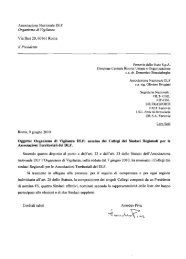Outlook for Air Transport to the Year 2015 - FILT CGIL Foggia
Outlook for Air Transport to the Year 2015 - FILT CGIL Foggia
Outlook for Air Transport to the Year 2015 - FILT CGIL Foggia
You also want an ePaper? Increase the reach of your titles
YUMPU automatically turns print PDFs into web optimized ePapers that Google loves.
Chapter 2. <strong>Air</strong> <strong>Transport</strong> Trends and Challenges 15The productivity measure is <strong>the</strong> overall index referred <strong>to</strong> above. An overall input price index has also beendeveloped from individual input prices. Input prices and yields are expressed in real terms (i.e. after removing <strong>the</strong>impact of general inflation). Financial per<strong>for</strong>mance is represented by <strong>the</strong> ratio of revenues <strong>to</strong> expenses, whereexpenses are defined <strong>to</strong> exclude taxes and interest.24. By and large, <strong>the</strong> productivity gains have not been retained by <strong>the</strong> airlines over <strong>the</strong> long term. Most of <strong>the</strong>cost savings associated with <strong>the</strong> full range of labour, fuel and aircraft productivity improvements have beenpassed on <strong>to</strong> <strong>the</strong> consumer in <strong>the</strong> <strong>for</strong>m of lower fares and rates. The impact of productivity improvements hasbeen offset <strong>to</strong> some extent by <strong>the</strong> increases in real input prices in <strong>the</strong> 1970s. A slight increase in <strong>the</strong>se prices canalso be observed in recent years which can be mainly attributed <strong>to</strong> <strong>the</strong> fuel price hike in 2000. In contrast, labourprices in <strong>the</strong> airline industry have had a reverse trend since 2001 due <strong>to</strong> traffic declines, both when compared <strong>to</strong>o<strong>the</strong>r operational cost items and <strong>the</strong> overall labour price index (<strong>for</strong> industrialized countries).25. Although <strong>the</strong>re have been substantial changes in <strong>the</strong> operating results of <strong>the</strong> airline industry in <strong>the</strong> shortand medium terms (see Chapter 4), <strong>the</strong>re has been nei<strong>the</strong>r an improving nor declining trend in financialper<strong>for</strong>mance over <strong>the</strong> long term. A significant sustained upward or downward trend would not be expectedbecause of <strong>the</strong> magnified impact such a trend would have on <strong>the</strong> levels of industry profits or losses.SAFETY AND QUALITY OF SERVICE26. <strong>Air</strong> transport has a strong tradition of giving <strong>to</strong>p priority <strong>to</strong> safety. While <strong>the</strong> traffic growth, productivityimprovement and cost and yield reductions described above have been occurring, a substantial improvement in<strong>the</strong> safety of air travel has been achieved. The number of passenger fatalities per 100 millionpassenger-kilometres flown has fallen from 0.8 in 1960 <strong>to</strong> 0.08 in 1980, 0.03 in 1990 and has ranged between0.05 and 0.02 since <strong>the</strong>n. The year 2002 saw 0.03 passenger fatalities per 100 million passenger-kilometres flown.27. There have also been significant enhancements in <strong>the</strong> quality of service provided <strong>to</strong> airline cus<strong>to</strong>mers.There are many dimensions <strong>to</strong> <strong>the</strong> quality of service, including journey time, convenience and reliability ofservice, com<strong>for</strong>t in <strong>the</strong> aircraft cabin and <strong>the</strong> range of on-board facilities. Some of <strong>the</strong>se fac<strong>to</strong>rs are difficult <strong>to</strong>measure in an objective fashion. However, increases in aircraft speed and average stage length have beenachieved, with positive consequences <strong>for</strong> journey times and passenger convenience. The global averageblock-<strong>to</strong>-block aircraft speed increased from 360 kilometres per hour (km/h) in 1960 <strong>to</strong> 630 km/h in 1980 and648 km/h in 2002 (an increase of 80 per cent over 1960). There has been little change in block speed since 1980.The average stage length has more than doubled from 470 kilometres in 1960 <strong>to</strong> 1 193 kilometres in 2002. Thislatter trend has been associated with more direct flights and fewer s<strong>to</strong>povers <strong>for</strong> refuelling, and hence a greaterlevel of convenience <strong>for</strong> <strong>the</strong> passenger. The combined effect of increased aircraft speeds and fewer s<strong>to</strong>poversreduced <strong>the</strong> <strong>to</strong>tal journey time from Sydney <strong>to</strong> London from three and a half days in 1950 <strong>to</strong> under one day in2002. Over <strong>the</strong> same period, <strong>the</strong> average journey time from New York <strong>to</strong> London was reduced from 17 hours <strong>to</strong>just under 7 hours.28. With <strong>the</strong> growth in air transport demand in response <strong>to</strong> fac<strong>to</strong>rs such as overall economic development,airlines have been able <strong>to</strong> increase service frequency and introduce non-s<strong>to</strong>p flights <strong>for</strong> a greater range ofcity-pairs without increasing costs. This improved service has, in turn, led <strong>to</strong> stimulation of demand in <strong>the</strong> longrun, although <strong>the</strong>re have also been short-term demand contractions due <strong>to</strong> so-called fear and hassle fac<strong>to</strong>rs ando<strong>the</strong>r non-economic fac<strong>to</strong>rs. While it is not possible <strong>to</strong> isolate cause and effect, <strong>the</strong> fact that aircraft departureshave increased by around 203 per cent between 1960 and 2002 is evidence of improvement in service frequencyand convenience.




